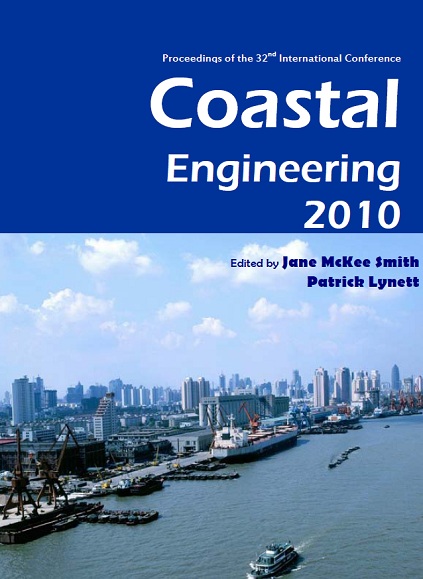Abstract
In 2008, a monitoring campaign of bay environment had been done at Tokyo Bay, Japan. This campaign has been a part of implementation of the bay renaissance plan enacted since 2005. The data was collected by 46 institutions in 568 monitoring points in around 2nd July 2008. Dissolved oxygen, salinity and temperature were monitored in sea area basically from the surface to the bottom with 1.0 m vertical spacing at the monitoring points. We analyzed spatial distribution of hypoxic water mass based on this monitoring campaign data. Following results are obtained that 1) Measurement results showed that the bottom hypoxic water mass dominated in the head of Tokyo bay, while dissolved oxygen concentration was high condition in tidal flat and in shallow water, such as the Tama River estuary, Sanbanze tidal flat area and the Ara River estuary. 2) We proposed new parameters, such as CDZ and VDZ, which showed characteristic of spatial distribution of hypoxic water. The proposed parameters could be related to the temporal and spatial development of hypoxic water. Thus, these parameters will extend the interpretation of conservative bottom dissolved oxygen (DOB) data to understand the dynamics of hypoxic water.References
Ando, H., Kashiwagi, N., Ninomiya, K., Ogura, H. and Kawai, T. (2005): Changes in the State of Water Pollution in Tokyo Bay since 1980 -Trend analysis of water quality using monitoring data obtained by Local Governments -, Annual report of the Tokyo Metropolitan Research Institute for Environmental Protection 2005, pp.141-150. (in Japanese)
Diaz, R.J. and Rosenberg, R. (2008): Spreading Dead Zones and Consequences for Marine Ecosystems, Science321, 926, 2.
Diaz, R.J. and Rosenberg, R. (2005): A review of its ecological effects and the behavioural responses of benthic macrofauna, Oceanogr. Mar. Biol. Ann. Rev., 33, pp.245-303.
Furukawa, K. and Okada, T. (2006): Tokyo Bay: Its Environmental Status-Past, Present, and Future, The Environment in Asia Pacific Harbors, 2006 Springer, pp.15-34.
Fujiwara, T., Takahashi, T., Yamada, Y. and Kaneko, A. (2000): Response of Hypoxic Water Mass in Tokyo Bay to the Variation in Hydrographic Condition Outside of the Bay, Oceanography in Japan, 9(6), pp.303-313. (in Japanese)http://dx.doi.org/10.5928/kaiyou.9.303
Horie, T., Furukawa, K. and Okada, T. (2009): Spatial Distribution of Hypoxic Water Mass Based on a Monitoring Campaign of Bay Environment at Tokyo Bay, Japan., Annual Journal of Civil Engineering in the Ocean, JSCE, Vol.26, pp.567-572. (in Japanese)
Mellor, G. L., (1991): An equation of state for numerical models of oceans and estuaries, J. Atmos. Oceanic Technol., 8, pp.609-611.http://dx.doi.org/10.1175/1520-0426(1991)008<0609:AEOSFN>2.0.CO;2
Nihei, Y., Takamura, T. and Watanabe, N. (2007): Issues on Discharge Monitoring in Main Influent Rivers into Tokyo Bay, Annual Journal of Coastal Engineering, JSCE, Vol.54, pp.1221-1225. (in Japanese)http://dx.doi.org/10.2208/proce1989.54.1221
Rabalais, N. N. (1999): Press release dated July 29, 1999, Louisiana Universities Marine Consortium, Chauvin, Louisiana.
Sasaki, J., Kawamoto, S., Yoshimoto, Y., Ishii, M. and Kakino, J. (2007): Evaluation of the Effect of Anoxic Water in Dredged Trenches on Blue Tides in Tokyo Bay, Annual Journal of Coastal Engineering, JSCE, Vol.54, pp.1041-1045. (in Japanese)http://dx.doi.org/10.2208/proce1989.54.1041
Toba, M., Kosemura, T., Yamakawa, H., Sugiura, Y. and Kobayashi, Y. (2008): Field and laboratory observations on the hypoxic impact on survival and distribution of short-necked clam Ruditapes philippinarum larvae in Tokyo Bay, central Japan., Plankton and Benthos Research, Vol.3, No.3, pp.165-173.http://dx.doi.org/10.3800/pbr.3.165
Yagi, H., Pokavanich, T., Susumu, Y., Nadaoka, K., Ariji, R., Matsuzaka, S., Suzuki, N., Moroboshi, K., Oda, R. and Ninei, Y. (2008a): Temporal and spatial variations of hypoxic water mass in Tokyo bay governed by the coastal upwelling at bay mouth and wind-driven current, Annual Journal of Coastal Engineering, JSCE, Vol.55, pp.1081-1085. (in Japanese)http://dx.doi.org/10.2208/proce1989.55.1081
Yagi, H., Pokavanich, T., Ise, H., Nadaoka, K., Ariji, R., Furudoi, K., Geshi, H., Furudono, T., Y. Oono (2008b): Influence of oceanic water intrusion on the coastal environment off Tama River Estuary of Tokyo bay in winter, Annual Journal of Coastal Engineering, JSCE, Vol.55, pp.1086-1090. (in Japanese)http://dx.doi.org/10.2208/proce1989.55.1086

